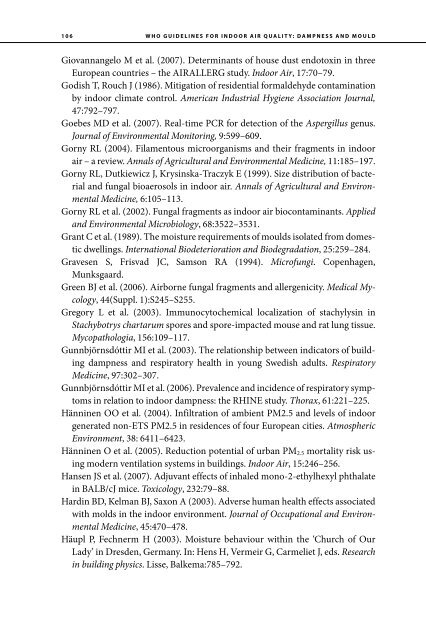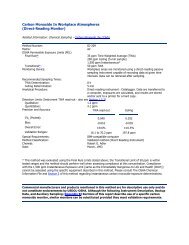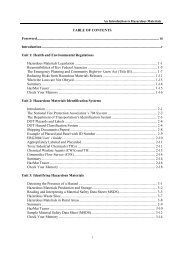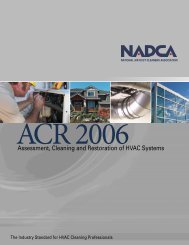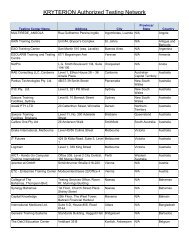Dampness and Mould - WHO guidelines for indoor air quality - PRWeb
Dampness and Mould - WHO guidelines for indoor air quality - PRWeb
Dampness and Mould - WHO guidelines for indoor air quality - PRWeb
Create successful ePaper yourself
Turn your PDF publications into a flip-book with our unique Google optimized e-Paper software.
106<br />
<strong>WHO</strong> GUIDELINES FOR INDOOR AIR QUALITY: DAMPNESS AND MOULD<br />
Giovannangelo M et al. (2007). Determinants of house dust endotoxin in three<br />
European countries – the AIRALLERG study. Indoor Air, 17:70–79.<br />
Godish T, Rouch J (1986). Mitigation of residential <strong>for</strong>maldehyde contamination<br />
by <strong>indoor</strong> climate control. American Industrial Hygiene Association Journal,<br />
47:792–797.<br />
Goebes MD et al. (2007). Real-time PCR <strong>for</strong> detection of the Aspergillus genus.<br />
Journal of Environmental Monitoring, 9:599–609.<br />
Gorny RL (2004). Filamentous microorganisms <strong>and</strong> their fragments in <strong>indoor</strong><br />
<strong>air</strong> – a review. Annals of Agricultural <strong>and</strong> Environmental Medicine, 11:185–197.<br />
Gorny RL, Dutkiewicz J, Krysinska-Traczyk E (1999). Size distribution of bacterial<br />
<strong>and</strong> fungal bioaerosols in <strong>indoor</strong> <strong>air</strong>. Annals of Agricultural <strong>and</strong> Environmental<br />
Medicine, 6:105–113.<br />
Gorny RL et al. (2002). Fungal fragments as <strong>indoor</strong> <strong>air</strong> biocontaminants. Applied<br />
<strong>and</strong> Environmental Microbiology, 68:3522–3531.<br />
Grant C et al. (1989). The moisture requirements of moulds isolated from domestic<br />
dwellings. International Biodeterioration <strong>and</strong> Biodegradation, 25:259–284.<br />
Gravesen S, Frisvad JC, Samson RA (1994). Microfungi. Copenhagen,<br />
Munksgaard.<br />
Green BJ et al. (2006). Airborne fungal fragments <strong>and</strong> allergenicity. Medical Mycology,<br />
44(Suppl. 1):S245–S255.<br />
Gregory L et al. (2003). Immunocytochemical localization of stachylysin in<br />
Stachybotrys chartarum spores <strong>and</strong> spore-impacted mouse <strong>and</strong> rat lung tissue.<br />
Mycopathologia, 156:109–117.<br />
Gunnbjörnsdóttir MI et al. (2003). The relationship between indicators of building<br />
dampness <strong>and</strong> respiratory health in young Swedish adults. Respiratory<br />
Medicine, 97:302–307.<br />
Gunnbjörnsdóttir MI et al. (2006). Prevalence <strong>and</strong> incidence of respiratory symptoms<br />
in relation to <strong>indoor</strong> dampness: the RHINE study. Thorax, 61:221–225.<br />
Hänninen OO et al. (2004). Infiltration of ambient PM2.5 <strong>and</strong> levels of <strong>indoor</strong><br />
generated non-ETS PM2.5 in residences of four European cities. Atmospheric<br />
Environment, 38: 6411–6423.<br />
Hänninen O et al. (2005). Reduction potential of urban PM 2.5 mortality risk using<br />
modern ventilation systems in buildings. Indoor Air, 15:246–256.<br />
Hansen JS et al. (2007). Adjuvant effects of inhaled mono-2-ethylhexyl phthalate<br />
in BALB/cJ mice. Toxicology, 232:79–88.<br />
Hardin BD, Kelman BJ, Saxon A (2003). Adverse human health effects associated<br />
with molds in the <strong>indoor</strong> environment. Journal of Occupational <strong>and</strong> Environmental<br />
Medicine, 45:470–478.<br />
Häupl P, Fechnerm H (2003). Moisture behaviour within the ‘Church of Our<br />
Lady’ in Dresden, Germany. In: Hens H, Vermeir G, Carmeliet J, eds. Research<br />
in building physics. Lisse, Balkema:785–792.


